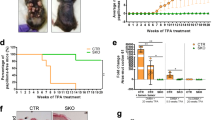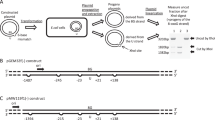Abstract
p53 has been postulated to be the guardian of the genome. However, results supporting the prediction that point mutation frequencies are elevated in p53-deficient cells either have not been forthcoming or have been equivocal. To analyse the effect of p53 on point mutation frequency, we used the supF gene of the pYZ289 shuttle vector as a mutagenic target. pYZ289 was treated in vitro by ultraviolet irradiation, aflatoxin B1, (±)7,8-dihydroxy-9,10-epoxy-7,8,9,10-tetrahydrobenzo[a]pyrene and meta-chloroperoxybenzoic acid and then transfected into p53-deficient cells with or without a p53 expression vector. p53 reduced the mutant frequency up to fivefold when pYZ289 was treated with aflatoxin B1, (±)7,8-dihydroxy-9,10-epoxy-7,8,9,10-tetrahydrobenzo[a]pyrene or meta-chloroperoxybenzoic acid but not when it was ultraviolet-irradiated. The p53-dependent mutation frequency reduction was higher at a higher level of premutational lesions for aflatoxin B1 and (±)7,8-dihydroxy-9,10-epoxy-7,8,9,10-tetrahydrobenzo[a]pyrene and at a lower level of lesions for meta-chloroperoxybenzoic acid. This suggests that the chemical mutagens produce, in a dose-dependent fashion, two kinds of DNA damage, one subject to p53-dependent mutation frequency reduction and the other not. These results indicate that p53 can reduce the point mutation frequency in a shuttle vector treated by chemical mutagens and suggest that p53 can act as guardian of the genome for at least some kinds of point mutations.
This is a preview of subscription content, access via your institution
Access options
Subscribe to this journal
Receive 50 print issues and online access
$259.00 per year
only $5.18 per issue
Buy this article
- Purchase on Springer Link
- Instant access to full article PDF
Prices may be subject to local taxes which are calculated during checkout



Similar content being viewed by others
References
Ames BN, McCann J and Yamasaki E. . 1975 Mutation Res. 31: 347–364.
Bouffler SD, Kemp CJ, Balmain A and Cox R. . 1995 Cancer Res. 55: 3883–3889.
Bradford MM. . 1976 Anal. Biochem. 72: 248–254.
Bristow RG, Jang A, Peacock J, Chung S, Benchimol S and Hill RP. . 1994 Oncogene 9: 1527–1536.
Chen XB, Ko LJ, Jayaraman L and Prives C. . 1996 Genes Dev. 10: 2438–2451.
Clarke AR, Howard LA, Harrison DJ and Winton DJ. . 1997 Oncogene 14: 2015–2018.
Courtemanche C and Anderson A. . 1994 Mutation Res. 306: 143–151.
Del Sal G, Manfioletti G and Schneider C. . 1989 Biotechniques 7: 514–519.
Donehower LA, Harvey M, Slagle BL, McArthur MJ, Montgomery CA, Butel JS and Bradley A. . 1992 Nature 356: 215–221.
Dower WJ, Miller JF and Ragsdale CW. . 1988 Nucleic Acids Res. 16: 6127–6145.
Foster PL, Eisenstadt E and Miller JH. . 1983 Proc. Natl. Acad. Sci. USA 80: 2695–2698.
Frebourg T and Friend SH. . 1992 J. Clin. Invest. 90: 1637–1641.
Giaccia AJ and Kastan MB. . 1998 Genes Dev. 12: 2973–2983.
Griffiths SD, Clarke AR, Healy LE, Ross G, Ford AM, Hooper ML, Wyllie AH and Greaves M. . 1997 Oncogene 14: 523–531.
Hall PA, McKee PH, Menage HD, Dover R and Lane DP. . 1993 Oncogene 8: 203–207.
Hartwell L. . 1992 Cell 71: 543–546.
Harvey DM and Levine AJ. . 1991 Genes Dev. 5: 2375–2385.
Harvey M, McArthur MJ, Montgomery CA, Butel JS, Bradley A and Donehower LA. . 1993a Nat. Genet. 5: 225–229.
Harvey M, Sands AT, Weiss RS, Hegi ME, Wiseman RW, Pantazis P, Giovanella BC, Tainsky MA, Bradley A and Donehower LA. . 1993b Oncogene 8: 2457–2467.
Havre PA, Yuan J, Hedrick L, Cho K and Glazer PM. . 1995 Cancer Res. 55: 4420–4424.
Hirt B. . 1967 J. Mol. Biol. 26: 365–369.
Ishizaki K, Nishizawa K, Mimaki S and Aizawa S. . 1996 Mutation Res. 364: 43–49.
Jacobsen JS and Humayun MZ. . 1986 Carcinogenesis 7: 491–493.
Johnson P, Gray D, Mowat M and Benchimol S. . 1991 Mol. Cell. Biol. 11: 1–11.
Kapp LN, Brown SL and Klevecz RR. . 1974 Biochim. Biophys. Acta 361: 140–143.
Kastan MB, Onyekwere O, Sidransky D, Vogelstein B and Craig RW. . 1991 Cancer Res. 51: 6304–6311.
Kuerbitz SJ, Plunkett BS, Walsh WV and Kastan MB. . 1992 Proc. Natl. Acad. Sci. USA 89: 7491–7495.
Laemmli UK. . 1970 Nature 227: 680–685.
Lane DP. . 1998 Nature 394: 616–617.
Lane DP. . 1992 Nature 358: 15–16.
Levy DD, Groopman JD, Lim SE, Seidman MM and Kraemer KH. . 1992 Cancer Res. 52: 5668–5673.
Livingstone LR, White A, Sprouse J, Livanos E, Jacks T and Tisty TD. . 1992 Cell 70: 923–935.
Lu X and Lane DP. . 1993 Cell 75: 765–778.
Maltzman W and Czyzyk L. . 1984 Mol. Cell. Biol. 4: 1689–1694.
Mariën K, Moyer R, Loveland P, van Holde K and Bailey G. . 1987 J. Biol. Chem. 262: 7455–7462.
Moriwaki S, Yagi T, Nishigori C, Imamura S and Takebe H. . 1991 Cancer Res. 51: 6219–6223.
Muench KF, Misrar RP and Humayun MZ. . 1983 Proc. Natl. Acad. Sci. USA 80: 6–10.
Murnane JP and Schwartz JL. . 1993 Nature 365: 22.
Nelson WG and Kastan MB. . 1994 Mol. Cell. Biol. 14: 1815–1823.
Nishino H, Knoll A, Buettner VL, Frisk CS, Maruta Y, Haavik J and Sommer SS. . 1995 Oncogene 11: 263–270.
Oren M, Maltzman W and Levine AJ. . 1981 Mol. Cell. Biol. 1: 101–110.
Peden KWC, Pipas JM, Pearson-White S and Nathans D. . 1980 Science 209: 1392–1396.
Rosenthal A, Sproat BS and Brown DM. . 1990 Biochem. Biophys. Res. Commun. 173: 272–275.
Sands AT, Suraokar MB, Sanchez A, Marth JE, Donehower LA and Bradley A. . 1995 Proc. Natl. Acad. Sci. USA 92: 8517–8521.
Sanger F, Nicklen S and Coulson AR. . 1977 Proc. Natl. Acad. Sci. USA 74: 5463–5467.
Selivanova G and Wiman KG. . 1995 Adv. Cancer Res. 66: 143–180.
Smith ML and Fornace Jr AJ. . 1996 Am. J. Pathol. 148: 1019–1022.
Trottier Y, Waithe WI and Anderson A. . 1992a Mutation Res. 281: 39–45.
Trottier Y, Waithe WI and Anderson A. . 1992b Mol. Carcinogen. 6: 140–147.
Wang EH, Friedman PN and Prives C. . 1989 Cell 57: 379–392.
Wei SJC, Chang RL, Wong CQ, Bhachech N, Cui XX, Hennig E, Yagi H, Sayer JM, Jerina DM, Preston BD and Conney AH. . 1991 Proc. Natl. Acad. Sci. USA 88: 11227–11230.
Wei SJC, Chang RL, Bhachech N, Cui XX, Merkler KA, Wong CQ, Hennig E, Yagi H, Jerina DM and Conney AH. . 1993 Cancer Res. 53: 3294–3301.
Wei SJC, Chang RL, Hennig E, Cui XX, Merkler KA, Wong CQ, Yagi H, Jerina DM and Conney AH. . 1994 Carcinogenesis 15: 1729–1735.
Yagi T, Mohri-Nakanishi K, Natsuda T, Yamagishi N, Miyakoshi J and Takebe H. . 1998 Cancer Lett. 123: 71–76.
Yamagishi N, Miyakoshi J and Takebe H. . 1997a Carcinogenesis 18: 695–700.
Yamagishi N, Miyakoshi J, Yagi T and Takebe H. . 1997b Mutagenesis 12: 191–194.
Yang J-L, Maher VM and McCormick JJ. . 1987 Proc. Natl. Acad. Sci. USA 84: 3787–3791.
Yin YX, Tainsky MA, Bischoff FZ, Strong LC and Wahl GM. . 1992 Cell 70: 937–948.
Yuan JL, Yeasky TM, Havre PA and Glazer PM. . 1995 Carcinogenesis 16: 2295–2300.
Acknowledgements
We thank T Yagi for the pYZ289 shuttle vector, S Benchimol for the pECM53 p53 expression vector, AJ Levine for the 10(3) cells, and MM Seidman for E. coli MBM7070 as well as for advice and encouragement concerning the use of shuttle vector mutagenesis systems. We also thank M Desrochers for providing the microsomes, A Loranger and N Marceau for advice on immunofluorescence techniques, as well as P Françon and E Pellerin for technical assistance. C Courtemanche held a graduate fellowship from the FCAR of Québec. This work was supported by the Medical Research Council.
Author information
Authors and Affiliations
Rights and permissions
About this article
Cite this article
Courtemanche, C., Anderson, A. The p53 tumor suppressor protein reduces point mutation frequency of a shuttle vector modified by the chemical mutagens (±)7,8-dihydroxy-9,10-epoxy-7,8,9,10-tetrahydrobenzo[a]pyrene, aflatoxin B1 and meta-chloroperoxybenzoic acid. Oncogene 18, 4672–4680 (1999). https://doi.org/10.1038/sj.onc.1202805
Received:
Revised:
Accepted:
Published:
Issue Date:
DOI: https://doi.org/10.1038/sj.onc.1202805



